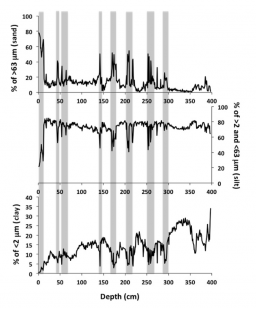
Fig. 1. Grain size population from the Mar Menor MM2 record with clay (< 2 μm), silt (> 2 and < 63 μm), and sand fraction (> 63 μm). Shaded areas mark the main variations of the sand fraction
Storms and tsunamis, which may seriously endanger human society, are amongst the most devastating marine catastrophes that can occur in coastal areas. Many such events are known and have been reported for the Mediterranean. In a sediment core from the Mar Menor (SE Spain), we discovered eight coarse-grained layers which document marine incursions during periods of intense storm activity or tsunami events. Based on radiocarbon dating, these extreme events occurred around 5250, 4000, 3600, 3010, 2300, 1350, 650, and 80 years cal BP. No comparable events have been observed during the 20thand 21st centuries. The results indicate little likelihood of a tsunami origin for these coarse-grained layers, although historical tsunami events are recorded in this region. These periods of surge events seem to coincide with the coldest periods in Europe during the late Holocene, suggesting a control by a climatic mechanism for periods of increased storm activity. Spectral analyses performed on the sand percentage revealed 4 major periodicities of 1228±327, 732±80, 562 ±58 and 319±16 years. Amongst the well -known proxies that have revealed a millennial-scale climate variability during the Holocene, the ice-rafted debris (IRD) indices in the North Atlantic developed by Bond et al. (1997, 2001) present a cyclicity of 1470±500 years, which matches the 1228±327-year periodicity evi-denced in the Mar Menor, considering the respective uncertainties in the periodicities. Thus, an in-phase storm activity in the western Mediterranean is found with the coldest periods in Europe and with the North Atlantic thermohaline circulation. However, further investigations, such as additional coring and high-resolution coastal imagery, are needed to better constrain the main cause of these multiple events.
L. Dezileau, A. Pérez-Ruzafa, P. Blanchemanche, J.-P. Degeai, O. Raji, P. Martinez, C. Marcos, U. von Grafenstein
Clim. Past, 12, 1389–1400.






